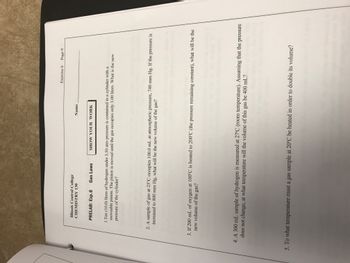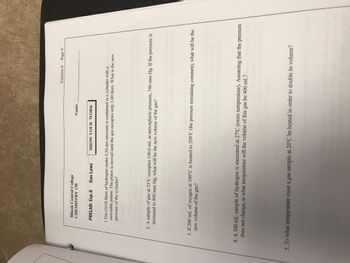Exercise 6 Page 9 Illinois Central College CHEMISTRY 130 Name PRELAB: Exp.6 Gas Laws SHOW YOUR WORK 1.Ten (10.0) liters of hydrogen under 3.50 atm pressure is contained in a cylinder with a moveable piston. The piston is moved until the gas occupies only 3.00 liters. What is the new pressure of the cylinder? 2. A sample of gas at 25°C occupies 100.0 mL at atmospheric pressure, 740 mm Hg. If the pressure is increased to 800 mm Hg, what will be the new volume of the gas? 3. If 200 mL of oxygen at 100°C is heated to 200°C (the pressure remaining constant), what will be the new volume of the gas? 4. A 300 mL sample of hydrogen is measured at 27°C (room temperature). Assuming that the pressure does not change, at what temperature will the volume of this gas be 400 mL? 5. To what temperature must a gas sample at 20°C be heated in order to double its volume?
Exercise 6 Page 9 Illinois Central College CHEMISTRY 130 Name PRELAB: Exp.6 Gas Laws SHOW YOUR WORK 1.Ten (10.0) liters of hydrogen under 3.50 atm pressure is contained in a cylinder with a moveable piston. The piston is moved until the gas occupies only 3.00 liters. What is the new pressure of the cylinder? 2. A sample of gas at 25°C occupies 100.0 mL at atmospheric pressure, 740 mm Hg. If the pressure is increased to 800 mm Hg, what will be the new volume of the gas? 3. If 200 mL of oxygen at 100°C is heated to 200°C (the pressure remaining constant), what will be the new volume of the gas? 4. A 300 mL sample of hydrogen is measured at 27°C (room temperature). Assuming that the pressure does not change, at what temperature will the volume of this gas be 400 mL? 5. To what temperature must a gas sample at 20°C be heated in order to double its volume?
Chemistry
10th Edition
ISBN:9781305957404
Author:Steven S. Zumdahl, Susan A. Zumdahl, Donald J. DeCoste
Publisher:Steven S. Zumdahl, Susan A. Zumdahl, Donald J. DeCoste
Chapter1: Chemical Foundations
Section: Chapter Questions
Problem 1RQ: Define and explain the differences between the following terms. a. law and theory b. theory and...
Related questions
Question

Transcribed Image Text:Exercise 6
Page 9
Illinois Central College
CHEMISTRY 130
Name
PRELAB: Exp.6
Gas Laws
SHOW YOUR WORK
1.Ten (10.0) liters of hydrogen under 3.50 atm pressure is contained in a cylinder with a
moveable piston. The piston is moved until the gas occupies only 3.00 liters. What is the new
pressure of the cylinder?
2. A sample of gas at 25°C occupies 100.0 mL at atmospheric pressure, 740 mm Hg. If the pressure is
increased to 800 mm Hg, what will be the new volume of the gas?
3. If 200 mL of oxygen at 100°C is heated to 200°C (the pressure remaining constant), what will be the
new volume of the gas?
4. A 300 mL sample of hydrogen is measured at 27°C (room temperature). Assuming that the pressure
does not change, at what temperature will the volume of this gas be 400 mL?
5. To what temperature must a gas sample at 20°C be heated in order to double its volume?
Expert Solution
This question has been solved!
Explore an expertly crafted, step-by-step solution for a thorough understanding of key concepts.
This is a popular solution!
Trending now
This is a popular solution!
Step by step
Solved in 5 steps with 3 images

Follow-up Questions
Read through expert solutions to related follow-up questions below.
Follow-up Question
#5

Transcribed Image Text:Illinois Central College
CHEMISTRY 130
PRELAB: Exp.6
Gas Laws
Name
SHOW YOUR WORK
Exercise 6
Page 9
1.Ten (10.0) liters of hydrogen under 3.50 atm pressure is contained in a cylinder with a
moveable piston. The piston is moved until the gas occupies only 3.00 liters. What is the new
pressure of the cylinder?
2. A sample of gas at 25°C occupies 100.0 mL at atmospheric pressure, 740 mm Hg. If the pressure is
increased to 800 mm Hg, what will be the new volume of the gas?
3. If 200 mL of oxygen at 100°C is heated to 200°C (the pressure remaining constant), what will be the
new volume of the gas?
4. A 300 mL sample of hydrogen is measured at 27°C (room temperature). Assuming that the pressure
does not change, at what temperature will the volume of this gas be 400 mL?
5. To what temperature must a gas sample at 20°C be heated in order to double its volume?
Solution
Follow-up Question
#5

Transcribed Image Text:Illinois Central College
CHEMISTRY 130
PRELAB: Exp.6
Gas Laws
Name
SHOW YOUR WORK
Exercise 6
Page 9
1.Ten (10.0) liters of hydrogen under 3.50 atm pressure is contained in a cylinder with a
moveable piston. The piston is moved until the gas occupies only 3.00 liters. What is the new
pressure of the cylinder?
2. A sample of gas at 25°C occupies 100.0 mL at atmospheric pressure, 740 mm Hg. If the pressure is
increased to 800 mm Hg, what will be the new volume of the gas?
3. If 200 mL of oxygen at 100°C is heated to 200°C (the pressure remaining constant), what will be the
new volume of the gas?
4. A 300 mL sample of hydrogen is measured at 27°C (room temperature). Assuming that the pressure
does not change, at what temperature will the volume of this gas be 400 mL?
5. To what temperature must a gas sample at 20°C be heated in order to double its volume?
Solution
Follow-up Question

Transcribed Image Text:---
### Illinois Central College
### CHEMISTRY 130
#### PRELAB: Exp. 6 - Gas Laws
---
#### Name: ________________________
---
**SHOW YOUR WORK**
1. **Ten (10.0) liters of hydrogen under 3.50 atm pressure is contained in a cylinder with a movable piston. The piston is moved until the gas occupies only 3.00 liters. What is the new pressure of the cylinder?**
2. **A sample of gas at 25°C occupies 100.0 mL at atmospheric pressure, 740 mm Hg. If the pressure is increased to 800 mm Hg, what will be the new volume of the gas?**
3. **If 200 mL of oxygen at 100°C is heated to 200°C (the pressure remaining constant), what will be the new volume of the gas?**
4. **A 300 mL sample of hydrogen is measured at 27°C (room temperature). Assuming that the pressure does not change, at what temperature will the volume of this gas be 400 mL?**
5. **To what temperature must a gas sample at 20°C be heated in order to double its volume?**
---
*Note to students: Remember to use appropriate gas laws such as Boyle's Law (P1V1 = P2V2), Charles's Law (V1/T1 = V2/T2), and the Combined Gas Law (P1V1/T1 = P2V2/T2) to solve these problems. Ensure you convert all temperatures to Kelvin before performing calculations.*
---
*(No graphs or diagrams are present in the provided document.)*
---
This document is intended for educational purposes as part of the Chemistry 130 course at Illinois Central College. Students are advised to carefully follow the instructions and show all necessary calculations in their answers.
---
Solution
Recommended textbooks for you

Chemistry
Chemistry
ISBN:
9781305957404
Author:
Steven S. Zumdahl, Susan A. Zumdahl, Donald J. DeCoste
Publisher:
Cengage Learning

Chemistry
Chemistry
ISBN:
9781259911156
Author:
Raymond Chang Dr., Jason Overby Professor
Publisher:
McGraw-Hill Education

Principles of Instrumental Analysis
Chemistry
ISBN:
9781305577213
Author:
Douglas A. Skoog, F. James Holler, Stanley R. Crouch
Publisher:
Cengage Learning

Chemistry
Chemistry
ISBN:
9781305957404
Author:
Steven S. Zumdahl, Susan A. Zumdahl, Donald J. DeCoste
Publisher:
Cengage Learning

Chemistry
Chemistry
ISBN:
9781259911156
Author:
Raymond Chang Dr., Jason Overby Professor
Publisher:
McGraw-Hill Education

Principles of Instrumental Analysis
Chemistry
ISBN:
9781305577213
Author:
Douglas A. Skoog, F. James Holler, Stanley R. Crouch
Publisher:
Cengage Learning

Organic Chemistry
Chemistry
ISBN:
9780078021558
Author:
Janice Gorzynski Smith Dr.
Publisher:
McGraw-Hill Education

Chemistry: Principles and Reactions
Chemistry
ISBN:
9781305079373
Author:
William L. Masterton, Cecile N. Hurley
Publisher:
Cengage Learning

Elementary Principles of Chemical Processes, Bind…
Chemistry
ISBN:
9781118431221
Author:
Richard M. Felder, Ronald W. Rousseau, Lisa G. Bullard
Publisher:
WILEY